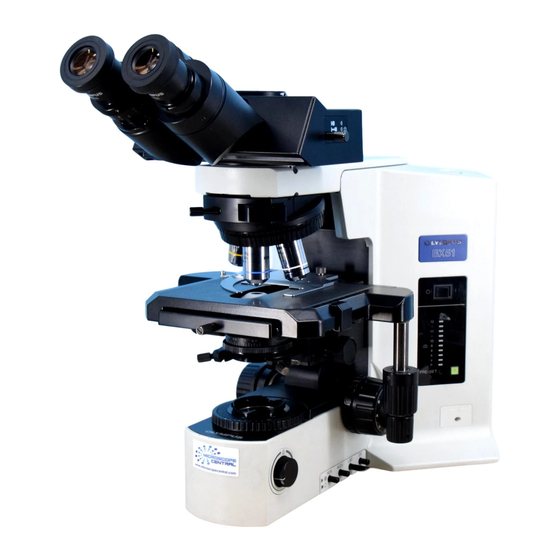Olympus BX52 Instructions Manual - Page 22
Browse online or download pdf Instructions Manual for Microscope Olympus BX52. Olympus BX52 37 pages. System

3-6 Immersion Objectives
Fig. 33
3-7 Objectives with Correction Collar
@
Fig. 34
20
1
Using Immersion Objectives
1. Focus on the specimen with a lower-power objective.
2. Place a drop of provided immersion oil onto the specimen at the area to
be observed.
3. Turn the revolving nosepiece to engage the immersion objective, then
focus using the fine adjustment knob.
# Since air bubbles in the oil will affect the image quality, make sure
that the oil is free of bubbles.
a. To check for bubbles, remove the eyepiece and fully open the field and
aperture iris diaphragms, then look at the exit pupil of the objective inside
the observation tube. (The pupil should appear round and bright.)
b. To remove bubbles, turn the revolving nosepiece to repeatedly defocus
and refocus the oil immersion objective.
}f the condenser engraving shows a numerical aperture (NA) of 1.0 or
higher, the number applies only when oil is applied between the slide
glass and the top surface of the condenser. When oil is not present, the
NA is about 0.9.
4. After use, remove oil from the objective front lens by wiping with gauze
slightly moistened with an ether (70%)/alcohol (30%) mixture.
Caution in use of immersion oil
If immersion oil enters your eyes or contacts with your skin, immediately
take the following treatment.
Eyes: Rinse with fresh water (for 15 minutes or more).
Skin: Rinse with water and soap.
If the appearance of the eyes or skin is altered or pain persists, immedi-
ately see your doctor.
}If the cover glass thickness is not 0.17 mm, the objectives cannot mani-
fest their performances. If a correction collar equipped objective is used
in this case, the difference in thickness can be compensated for by ad-
justing the collar.
Adjustment Procedure
· If the cover glass thickness is known, set the correction collar @ to that
value. (Fig. 34)
· If the cover glass thickness is unknown, adjust the correction collar @
and fine adjustment knob alternately until the positioning with the high-
est resolution is obtained.
# Be careful not to touch the correction collar @ when turning the
revolving nosepiece.
(Fig. 33)
